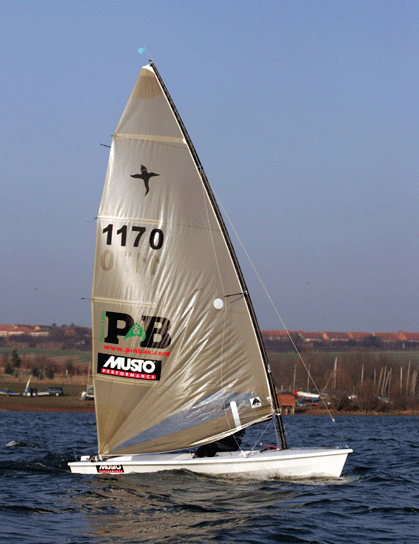Note that you can download all of this in the downloads section of the site
Article based on the set up used for the past 2 seasons, i.e. Vandercraft Epoxy Hull, fitted out by Pinnell & Bax with Kevlar Sail supported by Proctor/Selden Carbon Spars, this kit won the National and Inland Championships in 2005 in the hands of Simon Childs.
Please note that on non-epoxy hulls the use of rig tension should be significantly reduced to prevent damage / ensure longevity
General Set Up:
Pre-amble
| Wind Speed | Force 0-1.5 (Underpowered) | Force1.5 & 3.5 (Powered Up) | Force 3.5 + (Overpowered) |
| Mast Rake (to top of transom bar) | 6760mm | 6760mm - 6745mm | 6720mm - 6700mm (and less) |
| Mast Foot | 3300mm from back of mast to aft edge of transom bar | ||
| Rig Tension | 125kg / 275 lbs | 125kg / 275 lbs | 90kg / 200 lbs ( even less when howling) |
| Lowers | Always taught with full rig tension on / hold bottom section of mast straight | ||
| Kicker | None - Just enough to hold leech tension upwind | More than you think to help pointing, check top tell-tale flies. | As much as you can, remember to ease when tacking! |
| Cunningham | None | None until overpowered | Maximum to flatten sail |
| Outhaul - Beating | 30-40mm from band | 25mm from band | Out to the band |
| Centreboard | Full Down | Up 50mm / 2 in | Up 100mm or 4in + |
Up-wind
I am a firm believer in setting the boat up and then forgetting about it, don't get blown away by all those strings! Once on the water concentrate on setting the key adjustables i.e. Rig Tension and Kicker according to the conditions and then not too much tweaking - just concentrate on the windshifts, tactics and other boats
On the Race Track - Upwind
The key controls in my opinion are selecting the right amount of rig tension and getting the right amount of kicker tension. Up until you are becoming over-powered keep the rig tension fully on, and forget about it.
The Phantom leech is massive and upwind you will not point if you don't hold it pretty tight in all but the lightest of breeze. My initial memories were that you needed more kicker than you think, but the top telltales on the leech should still be streaming. Personal preference sort out whether to have a traveller or strop arrangement, I use a simple strop, this should allow you to sheet just inside the deck on flat water when the emphasis may be on squeezing some extra pointing ability and sacrificing speed, otherwise sheet the boom out over the corner of the deck.
As soon as you become overpowered it is time to lose the tension, raking the mast, flatten off the sail with lots of kicker and some cunningham as required, and start to raise the centreboard. This is largely about feel, and the controls should be calibrated so you can repeat what works. Practice makes perfect as always but, as a rule, being de-powered with the boom sheeted further out is far quicker than the lazy feathering up into the wind, especially in any sort of chop. Lighter helms may struggle in the medium winds as they are overpowered earlier and lose pointing ability, but as soon as everyone is over-powered technique and fitness count (watch Graham Scott as a good example).
The only problem is that, as you de-power the boom can get very near to the deck, you have to remember to ease kicker into a tack sometimes to prevent getting stuck under the boom in the middle of it!
Cunningham is largely a cosmetic device, use as little as possible, just get the worst creases out, leave the smaller "speed" creases in. Only really use cunningham when its breezy and you are overpowered. The tack of the sail is just tied on about 2 & 3 cm away from the mast.
Outhaul. Pretty obvious, normally 2-3 cm out from the Blue Band upwind until fully powered up, then flatten all the way out as required.
As regards lowers, I just set them taught with full rig tension on, and forget them.
Final comment is about where to sit in the boat. Positioning fore/aft does seem critical in certain conditions. In a drifter you can get in front of the mainsheet, not too far forward though, and scramble around when tacking. Make sure that you keep the transom from dragging. As the wind increases sit in the normal spot with your forward leg up against the traveller / strop. Only moving further back in bigger chop/waves
Another option for upwind is the Nick Beloe method. This involves letting the rig tension quite a way off and cranking the kicker on hard. This allows the rig to bend massively and depower in the gusts.
As you can see the end of the boom is right on or below the gunwale so rapid tacks are out of the question. If you want to see how to do it see the video section.
On the Race Track - Offwind
Reaching should be done with full rig tension, no cunningham and outhaul well eased, up to 6" or 150mm to really power the rig up. Ease the kicker to make the top 2 tell-tales fly and give a pleasant leech curve. Sit in the normal position until almost planning, and raise the board well up.
As the breeze increases de-power by releasing kicker (also keeps boom out of water) then tightening outhaul and cranking on cunningham when struggling. Also sliding back to get the boat planing on the flat aft section of the hull. When struggling be brave and bear away to go with the gust, luffing up/broaching/spilling wind is far too slow and boring!!
When dead running, the shrouds stop the boom squaring off. It seems to be fast to let all the rig tension off on a dead run, this allows the boom out further and is definitely fast, despite increasing the rake. Outhaul should be eased to 3" or 75mm from the band, and the "on one knee stance" is almost mandatory. Centreboard up as much as you dare & same goes for kicker! Don't worry that the forestay goes loose and waves around & but you need to remember to put the rig tension back on before the next leg though!!
Remember to use the waves as much as possible - it can make a huge difference!
If you need help or advice please ask anyone at the front of the fleet, even on the water while waiting to race, the Phantom Fleet prides itself on it "friendliness" and "gentlemanly" nature on the race track.









